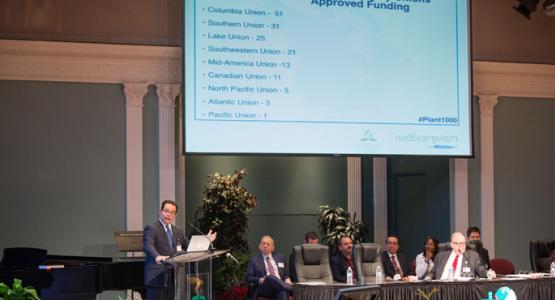
North American Division on Track to Open 300 New Churches This Year
Story by Andrew McChesney/ Adventist Review
The Seventh-day Adventist Church is on track to establish 300 new congregations across North America this year as part of an initiative to open 1,000 new churches over five years, a senior church officer said Sunday.
A total of 203 congregations were organized from Jan. 1 through Oct. 27, when North American Division president Daniel R. Jackson opened the division’s year-end meetings with a first annual update on the Plant1000 program. But the number had swelled to 215 by the time Jose Cortes Jr., who oversees church planting and evangelism for the NAD, gave a report about the program to the year-end meeting on Oct. 30.
Cortes announced that 300 new congregations might be established by Dec. 31 — and emphasized that the growth was vital to the life of the church.
“If we don’t plant churches, we will become a cul de sac in the Seventh-day Adventist highway,” Cortes told church leaders from across North America in the auditorium of the headquarters shared by the division and the General Conference in Silver Spring, Maryland.
The division also has set aside $10,000 per church plant, and Cortes said Sunday that the division funded 161 of the 215 congregations organized in 2016.
The North American Division, which has 1,231,006 members worshipping in 5,493 churches and 853 companies, agreed at its 2015 year-end meetings to implement the Plant1000 program to form 1,000 new congregations from 2016 to 2021. The division — which has found that new churches grow three to five times faster than established churches — intends to hold 12 special Seeds conferences (nadei.org) to promote church plants next year.
The division also has set aside $10,000 per church plant, and Cortes said that the division funded 161 of the 215 congregations organized in 2016.
Of those 161 new churches, 85 congregations were English speaking, 47 were Spanish speaking, and 29 were immigrant groups, including 12 refugee groups, according to statistics shared by Cortes. The largest number of new churches opened in the Columbia Union Conference (51), followed by the Southern Union Conference (31) and the Lake Union Conference (25). Rounding out the list of nine unions were the Atlantic Union Conference (3) and the Pacific Union Conference (1).
Cortes was joined on stage by several church planters, including Florida Conference president Mike Cauley and his own father, Jose Cortes, president of the New Jersey Conference, who spoke about their experiences.
Pastor Tim Madding told how his Beltsville (Maryland) church opened a new church plant in September to a crowd of 300 people in a dance studio less than a mile (2 kilometers) from the GC building in Silver Spring. He called the new Tech Road location a part of Beltsville church's multi-site plan, which is different from a traditional church plant. [Click here to read more about the multi-site approach of the Beltsville church.]
Anthony WagenerSmith, a church planter from Tampa Bay, Florida, said he learned that the process of organizing a new congregation was only part of the job. The most important part was nurturing its members to spiritual maturity, WagenerSmith said.
He was echoed by Hyveth Williams, professor at the Seventh-day Adventist Seminary at Andrews University and planter of the Grace Place congregation in a predominantly Roman Catholic neighborhood in South Bend, Indiana.
Winning Catholics is “easy peasy,” she said. “We’ve got to just love them.”
Cortes said love was the necessary ingredient for every new congregation. “If you are going to plant a church that doesn’t love all sinners, then please don’t plant the church,” he said.
— This article originally appeared on Adventist Review online.

Add new comment